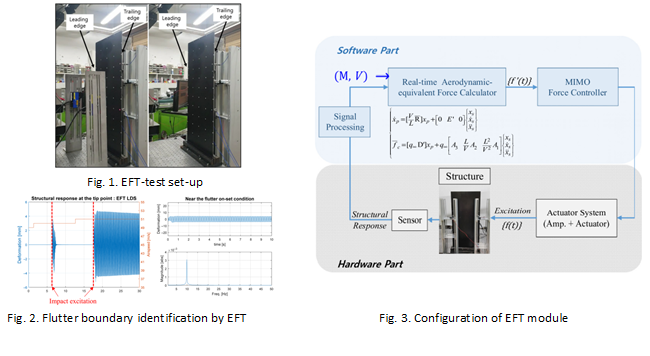d. Aeroelasticity: flutter and flow-induced vibration
Shock & Vibration Control

 Research
Research
 Shock & Vibration Control
Shock & Vibration Control
 d. Aeroelasticity: flutter and flow-induced vibration
d. Aeroelasticity: flutter and flow-induced vibration
d. Aeroelasticity: flutter and flow-induced vibration
Principal Investigator: Jae-Hung Han
Participated Graduate Research Assitant: Jong-min Yun, Dhital Kailash
Related Projects: ADD (HVRC)
Summary:
Team Aeroelasticity & Vibration aim to develop effective flutter test technique for the high-speed vehicle that could replace expensive and complicated conventional wind tunnel. The key challenge here is to simulate aerodynamic pressure on test structure with few concentrated forces exerted through shakers. The similar concept of “Dry Wind Tunnel” (DWT) has been developed for the subsonic region, but not for the supersonic region. We understand that the necessity of flutter testing technique like DWT for supersonic aircraft is prime. Therefore, this group is focused on establishing theoretical stand at this point for the ultimate experimental purpose.Related Recent Publication:
- [1] K. Dhital, J.-H. Han and Y.K. Lee, “Approximation of Distributed Aerodynamic Force to a Few Concentrated Forces for Studying Supersonic Panel Flutter,” Korean Society for Noise and Vibration Engineering, Vol. 26, pp. 518-527, 2016. [DOI]
- [2] K. Dhital and J.-H. Han, “MIMO Force Control of Electro-dynamic Shaker System Using Inverse Transfer Function Based Controller,” International Journal of Aeronautical and Space Sciences, Vol. 19, No. 1, pp. 80-88, Apr. 2018. [DOI]
- [3] J.-M. Yoon, J.-H. Han and Y.K. Lee, “MIMO Force Control of Electro-dynamic Shaker System Using Inverse Transfer Function Based Controller,” Korean Society for Noise and Vibration Engineering, Vol. 28, pp. 5-13, 2018. [DOI]
- [4] K. Dhital and J.-H. Han, “Panel Flutter Emulation Using a Few Concentrated Forces,” International Journal of Aeronautical and Space Sciences, Vol. 19, No. 1, pp. 80-88, Apr. 2018. [DOI]
- [5] J.-M. Yun and J.-H. Han, "Application of Ground Flutter Emulation Test Technique for the Passive Flutter Suppression Effect Validation," International Journal of Aeronautical and Space Sciences, 2021/07/29 2021, doi: 10.1007/s42405-021-00397-5.
Development of Flutter Emulation Techniques: Theoretical & Experimental
1.Goals
Development of simple and alternative ground flutter test technique for subsonic flow2. Approaches
Computation of real-time equivalent aerodynamic forces
Numerical application of few concentrated forces to emulate the flutter
Experimental implementation using compact actuator and sensors to perform real-time flutter testing
3. Recent Achievements
Development of advanced ground flutter emulation test method- Read-time equivalent aerodynamic force calculation based on doublet hybrid method (DHM).
- Emulated flutter testing module capable of simulating flutter with in the error of 6.2% as compare to wind-tunnel flutter testing.
- The present testing method is practical in predicating flutter boundary, flutter mode shape, and trend of aerodynamic damping effect.
- Application of the present testing technique in the passive flutter suppression.














